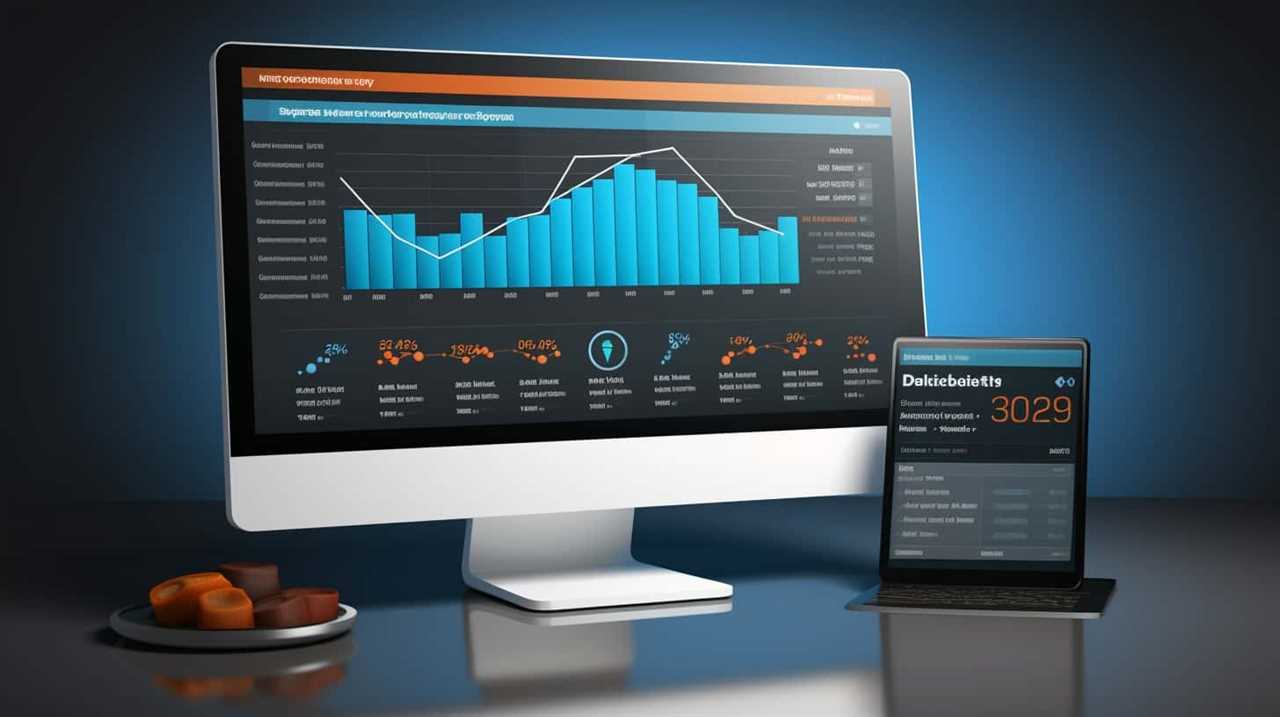Tired of your independent coffee shop being unnoticed online? Stress no more, because we’ve got the perfect solution for you.
In this article, we’ll show you how to grind out a strong online presence for your coffee shop using the power of SEO.
From understanding keyword research to optimizing your website and staying up to date with the latest trends, we’ve got you covered.
So grab a cup of joe, sit back, and let’s dive into the world of SEO for independent coffee shops.

Key Takeaways
- SEO is essential for coffee shops to increase online visibility and attract more customers.
- Targeting local coffee searches and incorporating specific location details into keywords is crucial.
- Analyzing competitors’ keyword strategies provides insights and opportunities for improvement.
- Prioritizing website optimization and creating compelling content are crucial for coffee shop SEO.
The Importance of SEO for Coffee Shops
SEO is essential for coffee shops to increase their online visibility and attract more customers. In today’s digital age, having a strong online presence is crucial for the success of any business, including coffee shops.
One important aspect of coffee shop SEO is the importance of local partnerships. By collaborating with other local businesses, coffee shops can benefit from increased visibility and reach a wider audience. This can be achieved through cross-promotion, joint events, or even sharing each other’s content on social media platforms.
Another strategy for optimizing coffee shop SEO is focusing on review platforms. Online reviews have become a powerful tool for consumers when making purchasing decisions. Coffee shops can leverage this by actively managing their presence on popular review platforms, such as Yelp or Google Reviews. Encouraging customers to leave positive reviews and promptly responding to any negative feedback can greatly impact a coffee shop’s online reputation and search engine rankings. Additionally, coffee shops can optimize their profiles on these platforms by including relevant keywords, updating business information, and uploading high-quality photos.
Understanding Keyword Research for Coffee Shops
When it comes to keyword research for coffee shops, targeting local coffee searches is crucial.

By identifying the specific location and incorporating it into your keywords, you can attract customers who are looking for coffee shops in your area.
Additionally, using long-tail keywords that include specific details about your cafe, such as the type of coffee you serve or the atmosphere, can help you stand out in search results.
Targeting Local Coffee Searches
How can we effectively target local coffee searches and understand keyword research for coffee shops? It’s essential for independent coffee shops to optimize their online presence and attract local customers. To achieve this, we need to focus on targeting local coffee searches through keyword research. Here are two key strategies to consider:
- Local coffee shop events: By including keywords related to local events, such as ‘coffee tasting event in [city name]’ or ‘live music at [coffee shop name],’ we can attract customers who are searching for specific activities in their area.
- Coffee shop loyalty programs: Many coffee lovers are interested in loyalty programs that offer rewards and discounts. By targeting keywords like ‘loyalty program for coffee shops’ or ‘coffee shop rewards program,’ we can appeal to customers who are looking for ways to save money and earn perks at their favorite local coffee spots.
Long-Tail Keywords for Cafes
To further enhance our local coffee shop’s online presence, let’s delve into the importance of utilizing long-tail keywords for cafes and understanding keyword research for coffee shops.

Long-tail keywords are specific and longer phrases that target niche audiences, enabling your coffee shop to rank higher in search engine results.
When conducting keyword research, it’s crucial to focus on terms related to coffee shop branding and coffee shop customer loyalty. By incorporating these keywords into your website content, blog posts, and social media profiles, you can attract and engage with your target audience effectively.
Analyzing Competitor Keyword Strategy
One essential step in understanding keyword research for coffee shops is analyzing our competitors’ keyword strategy. By examining the keywords that our competitors are targeting, we can gain valuable insights into their SEO efforts and identify untapped keyword opportunities in the coffee shop industry.
Here are some competitor analysis techniques for coffee shops’ keyword strategy:

- Conduct a thorough keyword analysis of our competitors’ websites and online content to identify the keywords they’re targeting.
- Use keyword research tools to analyze the search volume and competition level of the keywords our competitors are ranking for.
- Look for gaps or untapped opportunities in our competitors’ keyword strategy, such as targeting niche keywords or long-tail keywords that they may have overlooked.
- Monitor our competitors’ online presence and track any changes in their keyword strategy over time.
Optimizing Your Coffee Shop’s Website for SEO
We prioritize the optimization of our coffee shop’s website for SEO to enhance our online presence. A well-designed coffee shop website can attract more customers and boost our visibility in search engine results. To achieve this, we must focus on coffee shop website design and incorporate effective SEO strategies.
Coffee shop website design plays a crucial role in attracting and engaging visitors. It should be visually appealing, user-friendly, and mobile-responsive. A clean and organized layout, high-quality images, and easy navigation will create a positive user experience and encourage visitors to stay longer on our website.
To improve our website’s search engine rankings, we can learn from coffee shop SEO case studies. These case studies provide valuable insights into the best practices and strategies that have worked for other coffee shops. By analyzing their successes and failures, we can tailor our SEO efforts to suit our specific goals and target audience.
In addition to design and case studies, we should also focus on optimizing our website’s content. This includes conducting keyword research to identify relevant and high-ranking keywords, incorporating them naturally throughout our website, and creating informative and engaging content that resonates with our target audience.

Creating Compelling Content for Coffee Shop SEO
When it comes to creating compelling content for coffee shop SEO, there are a few key points to consider.
First, optimizing your visual coffee menu can help attract and engage customers online.
Second, blogging about coffee trends and industry news can showcase your expertise and drive traffic to your website.
Lastly, engaging social media posts that highlight your coffee offerings, promotions, and customer experiences can help build a strong online presence and attract new customers.

Visual Coffee Menu Optimization
To enhance the online visibility of our independent coffee shop, we optimize our visual coffee menu by strategically incorporating captivating content for SEO purposes. A well-designed coffee menu not only showcases the variety of drinks we offer but also reflects our unique coffee shop branding.
Here are two key ways we optimize our visual coffee menu:
- Eye-catching Images: We include high-quality, visually appealing images of our coffee drinks to entice customers and make them crave a visit to our shop.
- Descriptive Drink Descriptions: We craft engaging and enticing descriptions for each coffee drink, highlighting the flavors, origins, and brewing methods to create a sense of anticipation and intrigue.
Blogging About Coffee Trends
By exploring the latest coffee trends and blogging about them, we can create compelling content that boosts our coffee shop’s SEO and engages our online audience. Sharing valuable information about coffee brewing techniques and specialty coffee beans not only positions us as experts in the industry but also helps us attract coffee enthusiasts who are looking to stay updated with the latest trends.
When writing about coffee brewing techniques, we can provide step-by-step guides, tips, and recommendations, showcasing our expertise and building trust with our audience. Similarly, when discussing specialty coffee beans, we can highlight their unique flavors, origins, and brewing methods.

By consistently producing high-quality and informative blog posts, we can drive more traffic to our website, increase our online visibility, and ultimately, attract more customers to our coffee shop.
With our compelling content, we can now move on to creating engaging social media posts that further enhance our online presence.
Engaging Social Media Posts
Let’s now delve into the importance of creating engaging social media posts to further strengthen our coffee shop’s online presence and enhance our SEO efforts. Social media platforms are a powerful tool in reaching and engaging with our target audience.
Here are two effective strategies to create compelling content for coffee shop SEO:

- Engaging social media contests: By hosting contests on platforms like Instagram or Facebook, we can encourage our followers to actively participate and share our content, increasing our reach and engagement. This not only generates buzz around our coffee shop but also improves our online visibility.
- Collaborating with local artists for social media content: Partnering with local artists to create visually appealing and unique content for our social media platforms can help us stand out from the competition. It adds an artistic touch to our brand and provides valuable exposure for both the artist and our coffee shop.
By implementing these strategies, we can create a vibrant and engaging social media presence, driving more traffic to our website and ultimately boosting our SEO efforts.
Now, let’s explore how we can utilize local SEO strategies to further amplify our online visibility.
Utilizing Local SEO Strategies for Coffee Shops
We implement local SEO strategies to boost our coffee shop’s online presence and attract customers in our community. Local SEO is crucial for coffee shops because it helps us target customers in our immediate area and drive foot traffic to our shop. There are two key local SEO strategies that we focus on: leveraging online reviews and promoting coffee shop events.
Online reviews play a significant role in local SEO rankings. Positive customer reviews not only boost our credibility but also improve our visibility in local search results. To leverage positive reviews, we encourage our customers to leave feedback on popular review platforms like Google My Business, Yelp, and Facebook. We also respond to reviews promptly, showing potential customers that we value their feedback and are committed to providing excellent service.

Coffee shop events are another effective way to attract customers and improve local SEO rankings. By using local SEO strategies, we can promote our events and specials to our target audience. We optimize our website and social media profiles with relevant keywords and location-specific information. Additionally, we create event pages on our website and share them on local event listing websites. This helps us reach a wider audience and increase our chances of ranking higher in local search results.
By implementing these local SEO strategies, we can establish a strong online presence and attract customers in our community.
| Local SEO Strategy | Benefits |
|---|---|
| Leverage Online Reviews | – Boosts credibility |
- Improves visibility in local search results |
| Promote Coffee Shop Events | – Attracts customers - Improves local SEO rankings |
Building High-Quality Backlinks for Coffee Shop SEO
When it comes to building high-quality backlinks for coffee shop SEO, there are several effective strategies to consider.
One strategy is guest blogging, where we can contribute informative articles to relevant websites in exchange for a backlink to our coffee shop’s website.

Another strategy is listing our coffee shop on local business directories, which can help improve our online visibility and generate more backlinks.
Lastly, collaborating with influencers in the coffee industry can also help us build high-quality backlinks and reach a wider audience.
Guest Blogging Benefits
Building high-quality backlinks through guest blogging is a key strategy for improving coffee shop SEO.
Guest blogging outreach allows coffee shop owners to connect with influential bloggers in the industry and share valuable content on their platforms.

By writing guest posts on popular coffee blogs, coffee shop owners can reach a wider audience and establish themselves as experts in the field.
Measuring guest blogging success is essential to ensure that efforts are yielding positive results. Tools like Google Analytics can track the traffic generated from guest posts and provide insights into the effectiveness of the backlinks.
Additionally, guest blogging allows coffee shops to build relationships with other businesses and gain exposure to new customers.
As we transition into the next section about local business directories, it’s important to note that guest blogging is just one piece of the puzzle in creating a strong online presence for coffee shops.

Local Business Directories
To further enhance coffee shop SEO, a valuable strategy is to leverage local business directories for building high-quality backlinks. Local business directories are online platforms that list businesses in specific areas, allowing customers to discover and connect with them easily. By listing your coffee shop on these directories, you can increase your online visibility and attract more customers.
Additionally, local business directories often integrate Google Maps, which enables potential customers to find your coffee shop’s location easily. This integration is especially beneficial for coffee shops, as customers often rely on maps and directions to visit new places.
Furthermore, these directories also provide a platform for customers to leave online reviews, allowing you to navigate and respond to feedback effectively. By utilizing local business directories, you can improve your coffee shop’s SEO and establish a strong online presence.
Influencer Collaborations
We have found that collaborating with influencers is an effective way to build high-quality backlinks for coffee shop SEO. By partnering with social media influencers, coffee shops can tap into their large and engaged audiences, gaining exposure and credibility.

Here are two reasons why influencer partnerships are beneficial for coffee shop SEO:
- Increased online visibility: When influencers mention or promote your coffee shop on their social media platforms, it can drive traffic to your website and social media profiles. This increased visibility can lead to more backlinks from authoritative websites, boosting your search engine rankings.
- Authentic content creation: Influencers are skilled at creating engaging and authentic content that resonates with their audience. By collaborating with influencers, coffee shops can leverage their creativity and storytelling abilities to showcase their products and services in a compelling way, attracting more customers and potential backlinks.
Leveraging Social Media for Coffee Shop SEO
Our social media presence plays a significant role in driving organic traffic and improving search engine rankings for our independent coffee shop. Leveraging social media for coffee shop SEO involves two key strategies: social media engagement and influencer partnerships.
Social media engagement is crucial for building brand awareness, increasing online visibility, and driving traffic to our website. By regularly posting engaging content, responding to comments and messages, and interacting with our followers, we can create a strong online community around our coffee shop. This not only helps us connect with our customers but also signals to search engines that our business is active and relevant.
Influencer partnerships are another effective way to boost our coffee shop’s online presence. Collaborating with influencers in the coffee or food industry allows us to tap into their loyal following and leverage their influence to promote our brand. By partnering with influencers who align with our values and target audience, we can reach a wider audience and generate more engagement and visibility for our coffee shop.

Optimizing Your Coffee Shop’s Google My Business Listing
One essential step in strengthening our coffee shop’s online presence is optimizing our Google My Business listing. This is a powerful tool that allows us to showcase our coffee shop to potential customers searching for local businesses like ours. To maximize the impact of our listing, we should focus on two key areas: maximizing online reviews and optimizing coffee shop menu descriptions.
Here’s how we can make the most of our Google My Business listing:
- Maximizing online reviews:
- Encourage satisfied customers to leave positive reviews on our listing.
- Respond promptly and professionally to all reviews, whether positive or negative, to show that we value customer feedback.
- Optimizing coffee shop menu descriptions:
- Use descriptive and enticing language to highlight our specialty coffees, pastries, and other menu items.
- Include relevant keywords in our menu descriptions to improve our visibility in search results.
By implementing these strategies, we can improve our coffee shop’s online presence and attract more customers.
Monitoring and Analyzing Coffee Shop SEO Performance
To gauge the success of our SEO efforts, it’s crucial to monitor and analyze the performance of our coffee shop’s online presence. By tracking SEO performance metrics, we can determine the effectiveness of our strategies and make informed decisions to improve our rankings and visibility.

One way to monitor our coffee shop’s SEO performance is by conducting coffee shop SEO case studies. These studies involve analyzing data from our website, such as organic search traffic, keyword rankings, and conversion rates. By comparing this data to industry benchmarks and best practices, we can identify areas for improvement and optimize our SEO strategies accordingly.
Tracking SEO performance metrics is also essential for identifying trends and patterns. By monitoring metrics such as website traffic, bounce rate, and time on page, we can gain insights into how users interact with our website and identify any issues or areas for improvement. Additionally, tracking metrics like click-through rate (CTR) and conversion rate can help us measure the effectiveness of our SEO efforts in driving traffic and generating leads or sales.
Implementing Mobile-Friendly SEO for Coffee Shops
To improve our online presence and reach a wider audience, we need to optimize our coffee shop’s SEO strategies for mobile devices. As more and more people rely on their smartphones to search for local businesses, it’s crucial to have a mobile-friendly website design that provides a seamless user experience.
Here are a few key points to consider when implementing mobile-friendly SEO for your coffee shop:

- Responsive Design: Ensure that your website is designed to automatically adjust and adapt to different screen sizes and resolutions. This will make it easier for mobile users to navigate and engage with your content.
- Page Speed Optimization: Mobile users expect fast-loading websites. Optimize your website’s performance by compressing images, minifying code, and leveraging browser caching.
- Local Search Optimization: Make sure your coffee shop’s location, contact information, and operating hours are prominently displayed on your website. This will help search engines understand your business’s relevance to local searches.
By focusing on mobile-friendly website design and local search optimization, you can improve your coffee shop’s visibility in search engine results and attract more customers.
In the next section, we’ll explore how utilizing online directories can further enhance your coffee shop’s SEO efforts.
Utilizing Online Directories for Coffee Shop SEO
Now let’s delve into the topic of utilizing online directories to enhance our coffee shop’s SEO efforts and continue our discussion on optimizing our online presence for increased visibility and customer engagement. Online directories play a crucial role in helping coffee shops improve their search engine optimization (SEO) and increase their online visibility. By listing our coffee shop in popular online directories, we can improve our local search rankings, attract more customers, and manage our online reviews effectively.
One of the key benefits of utilizing online directories is the opportunity to build local citations. Local citations are mentions of our coffee shop’s name, address, and phone number (NAP) on external websites. These citations help search engines understand the relevance and credibility of our business, ultimately improving our search rankings. By consistently listing our coffee shop’s NAP information in relevant online directories, we can build a strong foundation for our SEO efforts.

Another advantage of online directories is the ability to manage our online reviews. Online review management is crucial for maintaining a positive online reputation and attracting new customers. By claiming our coffee shop’s listings on popular review platforms like Yelp, Google My Business, and TripAdvisor, we can respond to customer reviews, address any concerns or issues, and showcase our commitment to customer satisfaction.
To emphasize the importance of utilizing online directories for coffee shop SEO, here is a table showcasing the benefits:
| Benefits of Utilizing Online Directories for Coffee Shop SEO |
|---|
| Improved local search rankings |
| Increased online visibility |
| Effective online review management |
Staying up to Date With SEO Trends for Coffee Shops
As we continue our discussion on optimizing our online presence for increased visibility and customer engagement, let’s explore how staying up to date with SEO trends is essential for independent coffee shops.
In the rapidly evolving digital landscape, it’s crucial for coffee shop owners to stay informed about the latest SEO trends to ensure their websites rank high in search engine results and attract potential customers.

Here are two key reasons why staying up to date with SEO trends is important for coffee shop branding and customer retention:
- Improved visibility: By keeping up with SEO trends, coffee shop owners can optimize their websites with relevant keywords, meta tags, and backlinks, making it easier for search engines to find and rank their sites. This increased visibility can lead to more organic traffic and potential customers discovering their coffee shop online.
- Enhanced customer experience: SEO trends often focus on improving user experience, which is vital for coffee shop customer retention. By implementing techniques like mobile optimization and fast-loading web pages, coffee shop websites become more user-friendly and enjoyable to navigate. This positive user experience can encourage customers to stay on the website longer, explore the menu, and ultimately visit the physical coffee shop.
Frequently Asked Questions
How Can I Track the Performance of My Coffee Shop’s SEO Efforts?
We can track our coffee shop’s SEO efforts by using various tracking methods and coffee shop SEO analytics. These tools will provide us with valuable insights on the performance of our website and help us make informed decisions.
Are There Any Specific Online Directories That Are Beneficial for Coffee Shop Seo?
Yes, there are specific online directories that can greatly benefit coffee shop marketing. These directories help increase online visibility, drive traffic, and boost SEO rankings for independent coffee shops.
How Can I Ensure That My Coffee Shop’s Website Is Mobile-Friendly?
To ensure our coffee shop website is mobile-friendly, we focus on coffee shop website design and optimizing website load speed. By incorporating responsive design and optimizing images, we provide a seamless mobile browsing experience for our customers.

What Are Some Effective Strategies for Leveraging Social Media in Coffee Shop Seo?
Social media engagement and influencer marketing are effective strategies for coffee shop SEO. By leveraging social platforms and partnering with influencers, we can increase brand visibility, drive traffic to our website, and attract more customers.
What Are Some Current SEO Trends That Coffee Shop Owners Should Be Aware Of?
Voice search optimization and local SEO strategies are essential for coffee shop owners to stay competitive in the digital landscape. Did you know that 55% of consumers use voice search to find local businesses? Stay ahead by implementing these trends.
Conclusion
In conclusion, SEO is essential for independent coffee shops to establish a strong online presence and attract more customers. By conducting thorough keyword research, optimizing their website, creating compelling content, and utilizing local SEO strategies, coffee shops can improve their visibility in search engine results.
Monitoring and analyzing SEO performance, implementing mobile-friendly SEO, and utilizing online directories are also important steps. To stay ahead in the competitive coffee industry, it’s crucial for coffee shops to stay up to date with the latest SEO trends and adapt their strategies accordingly.

So, let’s grind our way to success!










